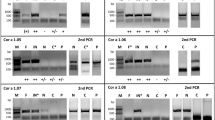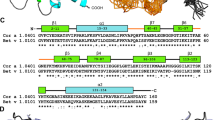Abstract
AIRBORNE grass pollens are a major cause of hayfever. The allergens involved are mostly proteins and glycoproteins1,2, which are stored in pollen walls3 and rapidly released on moistening and which seem to play a recognition role in pollen/stigma interactions4. The capacity of certain plant lectins to bind specific carbohydrates and glycoproteins5 and form precipitates with them in double diffusion tests6,7 indicates a means of investigating these substances in pollen. We report here how concanavalin A (con A), the lectin from jack beans, Canavalia ensiformis, differentiates among grasses by specifically precipitating wall-held materials from pollens mainly of nonfestucoid species. Furthermore, pollen of corn (Zea mays) and its closest relatives is easily distinguishable from that of other grasses by its characteristic reactions with con A.
This is a preview of subscription content, access via your institution
Access options
Subscribe to this journal
Receive 51 print issues and online access
$199.00 per year
only $3.90 per issue
Buy this article
- Purchase on Springer Link
- Instant access to full article PDF
Prices may be subject to local taxes which are calculated during checkout
Similar content being viewed by others
References
Augustin, R., and Hayward, B. J., Immunology, 5, 424–460, (1962).
Augustin, R., O'Sullivan, S., and Davies, I., Int. Arch. Allergy. appl. Immun., 41, 144–147 (1971).
Knox, R. B., and Heslop-Harrison, J., J. Cell Sci., 9, 238–251 (1971).
Heslop-Harrison, J., Heslop-Harrison, Y., Knox, R. B., and Mattsson, O., Biol. J. Linn. Soc., (in the press).
Lis, H., and Sharon, N., A. Rev. Biochem., 42, 541– (1973).
Goldstein, I. J., and So, L. L., Archs Biochem. Biophys., 111, 407– (1967).
So, L. L., and Goldstein, I. J., J. Immun., 99, 158–163 (1967).
Boreham, P., and Gill, G. S., Acta Tropica, 30, 356–365 (1973).
Marsh, D. G., Haddad, Z. H., and Campbell, D. H., J. Allergy, 46, 107–121 (1970).
Knox, R. B., Heslop-Harrison, J., and Reed, C., Nature, 225, 1066–1068 (1970).
Knox, R. B., J. Cell Sci., 9, 209–237 (1971).
Wright, W. L. T., and Clifford, H. T., Med. J. Aust., 2, 74–75 (1965).
Augustin, R., Immunology, 2, 148–169 (1959).
Marsh, D. G., Int. Arch. Allergy appl. Immun., 41, 199–215 (1970).
Mangelsdorf, P. C., in Crop Plant Evolution (edit. by Hutchinson, Sir J.), 23–49 (Cambridge University Press, 1965).
Mattsson, O., Knox, R. B., Heslop-Harrison, J., and Heslop-Harrison, Y., Nature, 247, 298 (1974).
Oikawa, T., Yanagimachi, R., and Nicolson, G. L., Nature, 241, 256–259 (1973).
Author information
Authors and Affiliations
Rights and permissions
About this article
Cite this article
WATSON, L., KNOX, R. & CREASER, E. Con A differentiates among grass pollens by binding specifically to wall glycoproteins and carbohydrates. Nature 249, 574–576 (1974). https://doi.org/10.1038/249574a0
Received:
Issue Date:
DOI: https://doi.org/10.1038/249574a0
This article is cited by
-
Exogenous sugars overcome incompatibility in hazelnut (Corylus avellana L.)
Theoretical and Applied Genetics (1986)
-
Detection in primitive gymnosperms of proteins and glycoproteins of possible significance in reproduction
Nature (1977)
-
Lectins stimulate pollen germination
Nature (1975)
Comments
By submitting a comment you agree to abide by our Terms and Community Guidelines. If you find something abusive or that does not comply with our terms or guidelines please flag it as inappropriate.



